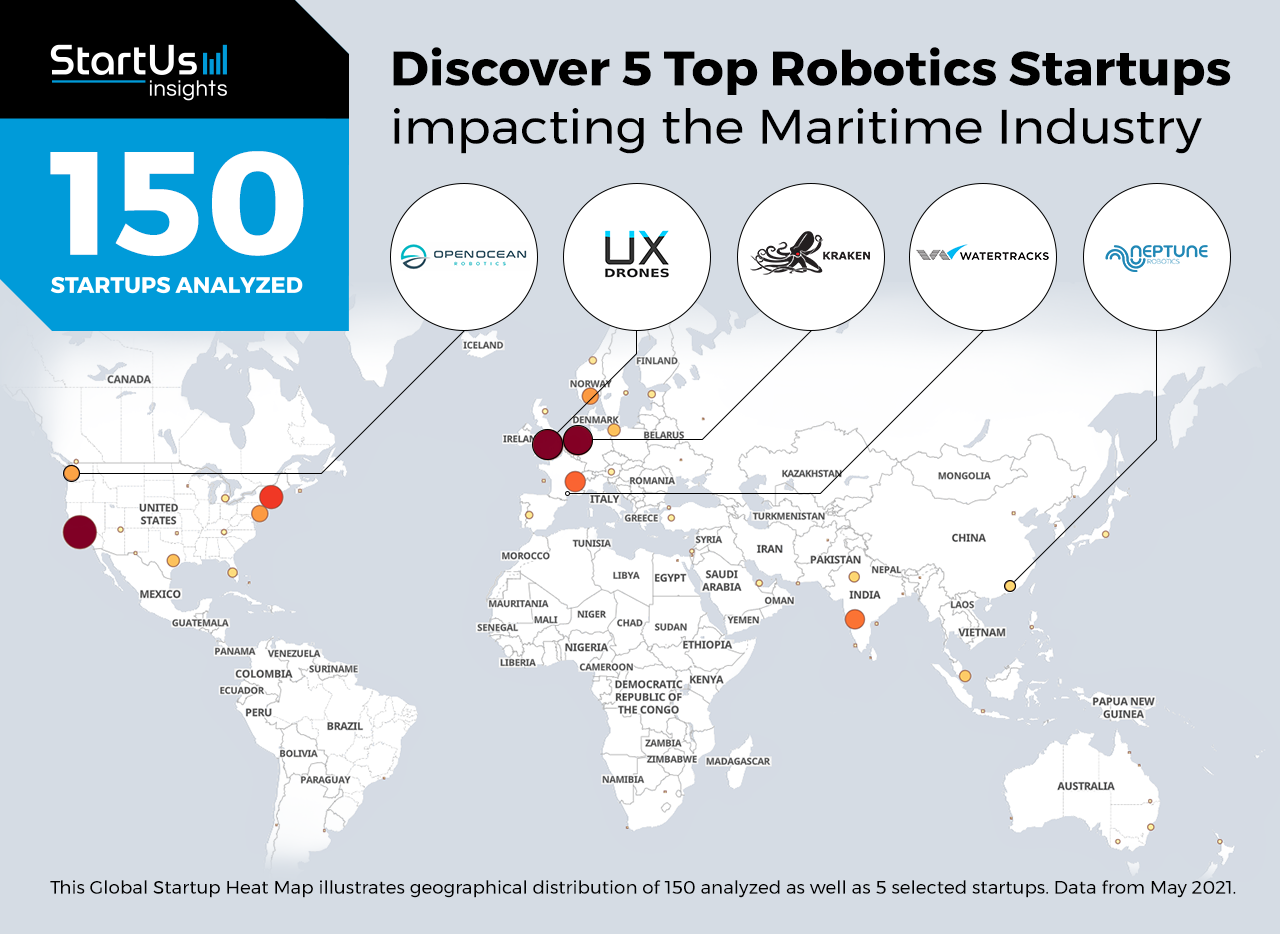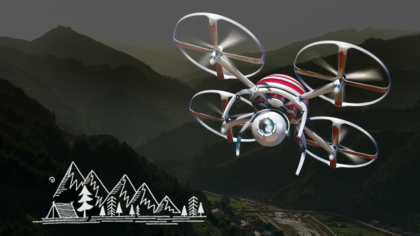Accelerate Productivity in 2025
Reignite Growth Despite the Global Slowdown
Staying ahead of the technology curve means strengthening your competitive advantage. That is why we give you data-driven innovation insights into the maritime industry. This time, you get to discover 5 hand-picked maritime robotics startups.
Global Startup Heat Map highlights 5 Top Robotics Startups out of 150
The insights of this data-driven analysis are derived from the Big Data & Artificial Intelligence-powered StartUs Insights Discovery Platform, covering 2.093.000+ startups & scaleups globally. The platform gives you an exhaustive overview of emerging technologies & relevant startups within a specific field in just a few clicks.
The Global Startup Heat Map below reveals the distribution of the 150 exemplary startups & scaleups we analyzed for this research. Further, it highlights 5 maritime startups that we hand-picked based on criteria such as founding year, location, funding raised, and more. You get to explore the solutions of these 5 startups & scaleups in this report. For insights on the other 145 maritime robotics startups, get in touch.
Neptune Robotics’ automates Hull Cleaning
Brush cleaning and other manual hull cleaning methods are being replaced with remotely operated vehicles (ROVs). However, the damage to the ship’s anti-fouling paint, as well as biofouling, creates challenges for the maritime industry. For instance, damage to anti-fouling coating while hull cleaning spreads invasive species and fouling debris across the ship. To this end, startups are developing cleaning solutions for ship owners and operators.
Neptune Robotics is a Chinese startup that tackles conventional maritime challenges using its hull cleaning solution. Capable of operating above and underwater, its robots effectively vibrate away the fouling while protecting the vessel’s anti-fouling paint. This reduces friction and improves the fuel efficiency of maritime logistics. Neptune uses big data and AI to digitize hulls and provide insights for fleet management at ports and anchorages. Further, the startup curbs GHG emissions using its debris collection and filtration system.
Open Oceanic Robotics enables Oceanic Data Collection
Oceanic data collection is currently a cumbersome process with the deployment of heavy-duty vessels that lack maneuverability. Further, such vessels create environmental pollution from high emissions. That is why startups and scaleups are developing smart solutions with self-sustaining and real-time data collection, even in remote oceans. These solutions are also durable for long-haul operations for researchers.
Canadian startup Open Ocean Robotics develops an uncrewed surface vehicle (USV) called Data Xplorer. The USV undertakes research operations of up to 6 months while providing secure real-time data. Data Xplorer is also lightweight and self-righting and is capable of withstanding even harsh sea conditions. Equipped with an AML sensor bay, the USV features a variety of oceanographic sensors, such as chlorophyll, turbidity, salinity, and dissolved oxygen. Further, an optional transducer mount integrates a multibeam depth sounder or side-scan sonar. The startup also offers additional sensors to install including radar, thermal cameras, and hydrophone arrays.
Kraken Robotik develops a Subsea 3D Scanning Device
The majority of subsea infrastructure requires frequent maintenance and 3D scanning increasingly plays an important role. 3D scanning suffers from the mismatch between data availability and actual operations, a lack of computing power, and bulky designs. This is why startups are designing 3D scanning solutions that are easy to use while providing accurate and high-resolution point cloud images of subsea infrastructure.
German startup Kraken Robotik offers SEAVISION, an underwater imaging system. The system uses a full-color laser scanning process that repeats thousands of times per second to generate coordinate values of millions of points on a reflected surface. SEAVISION uses a low-light camera, high-power LED, and steerable RGB-line lasers to generate high-resolution 3D point cloud images of subsea infrastructure. Further, the system is designed for deployment on underwater robotic platforms such as ROVs and autonomous underwater vehicles (AUVs).
Watertracks designs Robotic Dredging Solutions
Traditionally, dredging and excavation are performed closer to the shore. On the other hand, construction & maintenance of ports and waterways requires extended operational distance. For this, startups are developing innovative machines that operate away from shorelines while ensuring operational efficiency. These machines work in tandem with surface support vessels and even use immersive technologies to successfully perform underwater operations.
Based in France, Watertracks is a maritime startup offering virtual reality (VR)-based robotic machines that carry out excavation, dredging, burials, and decontamination of polluted sites. The startup robots include the ANAIS 952HD Underwater Excavator, NESSIE Dredging Robot, SANDRA Surface Barge, and bondage boats. These machines autonomously perform operations at a distance of up to 100 meters from the shoreline. Watertracks enables automation for private and public works, such as dam cleaning, and is now conducting intensive dredging trials to fully automate dredging operations.
UXDrones offers Autonomous Underwater Robots
Autonomous underwater robots are programmed to undergo specialized remote and unexplored missions. However, such vessels currently lack maneuverability, long-distance durability, and high-speed communications. This increases costs and decreases efficiency for operations such as search & rescue and data collections. As a result, startups are working on self-sustaining solutions that provide 3D motion freedom with high-speed communications.
UX Drones is a British startup developing collaborative underwater robots that utilize a patent-pending, integrated rotating thruster propulsion system. The portability of this robot allows it to maneuver in tight spaces and 3D motion enables the orientation and positioning, required to undertake search and rescue missions. The robots use machine learning (ML) algorithms to adapt to currents, wear and tear, and operator preferences. Further, the drones utilize wireless communicators to provide high-speed communication with other robots, divers, and relay buoys up to 100 meters away.
Discover more Maritime Startups
Maritime startups such as the examples highlighted in this report focus on subsea operations, ship inspection, and ocean exploration. While all of these technologies play a major role in advancing the maritime industry, they only represent the tip of the iceberg. To explore more maritime technologies, simply get in touch to let us look into your areas of interest. For a more general overview, you can download our free Industry Innovation Reports to save your time and improve strategic decision-making.








